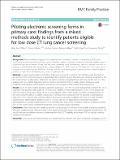Files in this item
Piloting electronic screening forms in primary care : findings from a mixed methods study to identify patients eligible for low dose CT lung cancer screening
Item metadata
| dc.contributor.author | O’Brien, Mary Ann | |
| dc.contributor.author | Sullivan, Frank | |
| dc.contributor.author | Carson, Andrea | |
| dc.contributor.author | Siddiqui, Rabiya | |
| dc.contributor.author | Syed, Saddaf | |
| dc.contributor.author | Paszat, Lawrence | |
| dc.date.accessioned | 2017-11-28T16:30:07Z | |
| dc.date.available | 2017-11-28T16:30:07Z | |
| dc.date.issued | 2017-11-28 | |
| dc.identifier | 251637701 | |
| dc.identifier | e931fa46-a73e-4a14-b9f2-0fd0e9cfe137 | |
| dc.identifier | 85035203405 | |
| dc.identifier | 000416462100001 | |
| dc.identifier.citation | O’Brien , M A , Sullivan , F , Carson , A , Siddiqui , R , Syed , S & Paszat , L 2017 , ' Piloting electronic screening forms in primary care : findings from a mixed methods study to identify patients eligible for low dose CT lung cancer screening ' , BMC Family Practice , vol. 18 , 95 . https://doi.org/10.1186/s12875-017-0666-5 | en |
| dc.identifier.issn | 1471-2296 | |
| dc.identifier.other | RIS: urn:0F05D4273081876393D662DFC48388FF | |
| dc.identifier.other | RIS: O’Brien2017 | |
| dc.identifier.other | ORCID: /0000-0002-6623-4964/work/39245054 | |
| dc.identifier.uri | https://hdl.handle.net/10023/12184 | |
| dc.description | This study was funded by The Ontario Cancer Screening Research Network. | en |
| dc.description.abstract | Background: Recent evidence suggests that screening with low dose computed tomography (LDCT) scans significantly reduces mortality from lung cancer. However, optimal methods to identify potentially eligible patients in primary care are not known. Using brief electronic screening forms administered prior to a primary care visit is a strategy to identify high risk, asymptomatic patients eligible for LDCT screening. The objective of this study was to compare the acceptability and feasibility of using brief electronic versus paper screening forms to identify eligible patients at high risk of developing lung cancer in primary care. Methods: A mixed method pilot comparative study was conducted in primary care. Practices were allocated to an electronic form (e-form) group or a paper-based form (p-form) group. Allocation was randomly assigned for the first practice then by alternation. Patients in the e-form practices completed forms at home via the web or in the waiting room on a tablet. Patients in p-form practices completed forms in waiting rooms. Interviews were conducted with patients, administrators, and primary care physicians (PCPs) about their experiences. Results: Six of 30 (20%) eligible practices agreed to participate. Over the 16-week study period, a total of 831 of an expected 1442 patients (58%) aged 55–74 years were enrolled; 573/690 (83%) patients in the e-form group and 258/752 (34%) in the p-form group. Of the 573 participants in the e-form group, 335 (58%) completed forms via the web; 238 (29%) did so via tablet. Twenty-four interviews were conducted with 15 patients, 5 administrative staff and 4 PCPs. Patients were willing to discuss lung cancer screening eligibility with their PCP. Staff members expressed low administrative burden except for an extra step to link appointment information to patient demographics to identify eligible patients. PCPs indicated that forms were reminders to discuss smoking cessation. PCPs in the e-form group reported that patients asked questions about screening. Conclusion: There was fairly low uptake by primary care practices. For e-forms to be feasible in practice workflow, electronic medical record software needs to link appointment information with patient eligibility requirements. The use of brief pre-consultation electronic screening forms for LDCT eligibility encouraged PCPs to discuss smoking cessation with patients. | |
| dc.format.extent | 9 | |
| dc.format.extent | 603363 | |
| dc.language.iso | eng | |
| dc.relation.ispartof | BMC Family Practice | en |
| dc.subject | Lung cancer screening | en |
| dc.subject | Primary care | en |
| dc.subject | Health services research | en |
| dc.subject | Low dose computed tomography (LDCT) | en |
| dc.subject | RC0254 Neoplasms. Tumors. Oncology (including Cancer) | en |
| dc.subject | RA0421 Public health. Hygiene. Preventive Medicine | en |
| dc.subject | E-DAS | en |
| dc.subject | SDG 3 - Good Health and Well-being | en |
| dc.subject.lcc | RC0254 | en |
| dc.subject.lcc | RA0421 | en |
| dc.title | Piloting electronic screening forms in primary care : findings from a mixed methods study to identify patients eligible for low dose CT lung cancer screening | en |
| dc.type | Journal article | en |
| dc.contributor.institution | University of St Andrews. School of Medicine | en |
| dc.contributor.institution | University of St Andrews. Population and Behavioural Science Division | en |
| dc.identifier.doi | https://doi.org/10.1186/s12875-017-0666-5 | |
| dc.description.status | Peer reviewed | en |
This item appears in the following Collection(s)
Items in the St Andrews Research Repository are protected by copyright, with all rights reserved, unless otherwise indicated.

